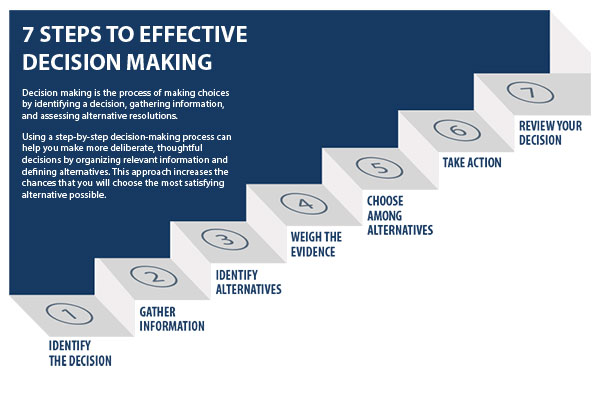A decision is a judgement or choice between two or more alternatives and arises in an infinite number of situations; from the resolution of a problem to the implementation of a course of action.
Individuals in organizations make decisions. That is, they make choices from among two or more alternatives. Top managers, for instance, determine their organization’s goals, what products or services to offer, how best to organize corporate headquarters, or where to locate a new manufacturing plant. Middle- and lower-level managers determine production schedules, select new employees and decide how pay raises are to be allocated. Of course, making decisions is not the sole province of managers. Non-managerial employees also make decisions that affect their jobs and the organizations they work for. The more obvious of these decisions might include whether to come to work or not on any given day, how much effort to put forward once at work, and whether to comply with a request made by the boss. Individual decision-making, therefore, is an important part of organizational behaviour. But, choices are largely influenced by their perceptions.
Decision-making occurs as a reaction to a problem. There is a discrepancy between some current and some desired states, requiring consideration of alternative courses of action.
Every decision requires the interpretation and evaluation of information. Data is typically received from multiple sources and needs to be screened, processed and interpreted. What data, for instance, is relevant to the decision and what data isn’t? The perception of the decision-maker will answer this question. Alternatives will be developed and the strengths and weaknesses of each will need to be evaluated. Again, because alternatives don’t come with “red flags” identifying themselves as such, or with their strengths and weaknesses clearly marked, the individual decision-maker's perceptual process will have a large bearing on the outcome.

Click here to listen to an explanation of the steps in the decision-making process.
Click here to view a video on the seven steps to improving the decision-making process.
Group Dynamics and Team Decisions
Kurt Lewin, a social psychologist and change management expert, is credited with coining the term "group dynamics" in the early 1940s. He noted that people often take on distinct roles and behaviours when they work in a group. "Group dynamics" describes the effects of these roles and behaviours on other group members, and on the group.
A group with a positive dynamic is easy to spot. Team members trust one another, they work towards a collective decision, and they hold one another accountable for making things happen.
In a group with poor group dynamics, people's behaviour disrupts work. As a result, the group may not come to any decision, or it may make the wrong choice because group members could not explore options effectively.
What Causes Poor Group Dynamics?
Group leaders and team members can contribute to a negative group dynamic. Let's look at some of the most common problems that can occur:
Weak Leadership: When a team lacks a strong leader, a more dominant member of the group can often take charge. This can lead to a lack of direction, infighting, or a focus on the wrong priorities.
Excessive Deference to Authority: This can happen when people want to be seen to agree with a leader, and therefore hold back from expressing their own opinions.
Blocking: This happens when team members behave in a way that disrupts the flow of information in the group. People can adopt blocking roles such as:
- The aggressor - this person often disagrees with others or is inappropriately outspoken.
- The negator - this group member is often critical of others' ideas.
- The withdrawer - this person doesn't participate in the discussion.
- The recognition seeker - this group member is boastful or dominates the session.
- The joker - this person introduces humour at inappropriate times.
“Groupthink”: This happens when people place a desire for consensus above their desire to reach the right decision. This prevents people from fully exploring alternative solutions.
Free Riding: Here, some group members take it easy and leave their colleagues to do all the work. Free riders may work hard on their own, but limit their contributions in group situations; this is known as "social loafing".
Evaluation Apprehension: Team members' perceptions can also create a negative group dynamic. Evaluation apprehension happens when people feel that they are being judged excessively harshly by other group members, and they hold back their opinions as a result.